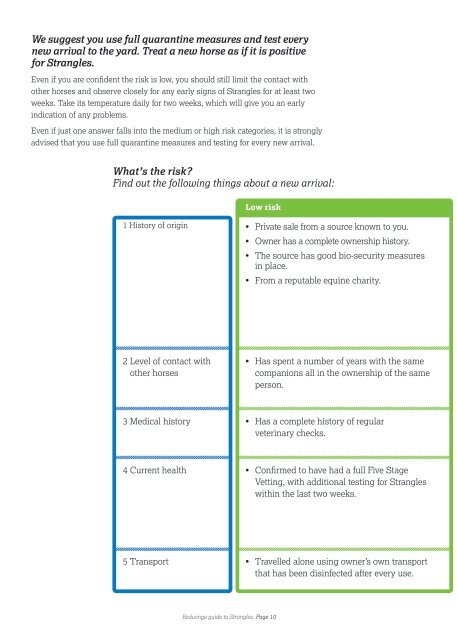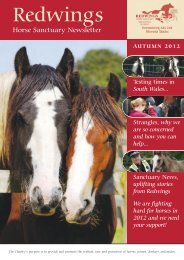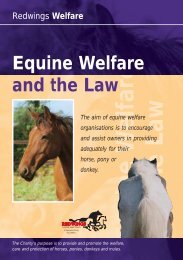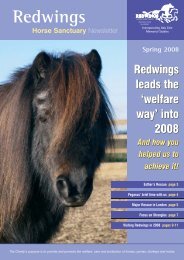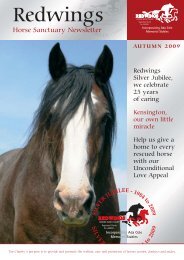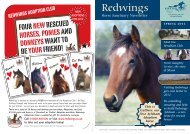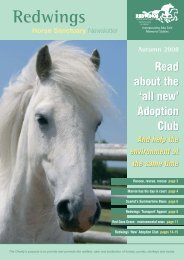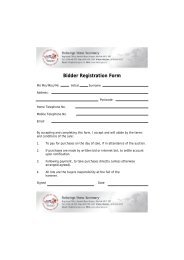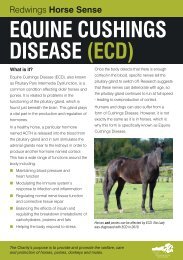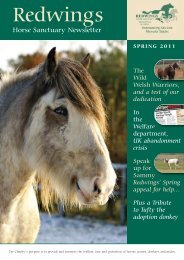STRANGLES - Redwings
STRANGLES - Redwings
STRANGLES - Redwings
You also want an ePaper? Increase the reach of your titles
YUMPU automatically turns print PDFs into web optimized ePapers that Google loves.
We suggest you use full quarantine measures and test every<br />
new arrival to the yard. Treat a new horse as if it is positive<br />
for Strangles.<br />
Even if you are confident the risk is low, you should still limit the contact with<br />
other horses and observe closely for any early signs of Strangles for at least two<br />
weeks. Take its temperature daily for two weeks, which will give you an early<br />
indication of any problems.<br />
Even if just one answer falls into the medium or high risk categories, it is strongly<br />
advised that you use full quarantine measures and testing for every new arrival.<br />
What’s the risk?<br />
Find out the following things about a new arrival:<br />
Is the risk high or low?<br />
Low risk Medium risk High risk<br />
1 History of origin<br />
• Private sale from a source known to you.<br />
• Owner has a complete ownership history.<br />
• The source has good bio-security measures<br />
in place.<br />
• From a reputable equine charity.<br />
• Private sale with some ownership history<br />
and some history of vet checks.<br />
• Previous location seemingly of a<br />
good standard.<br />
• No ownership history available<br />
• From a busy field/yard with lots of horse<br />
movements, or onsite competitions.<br />
• From a yard or area that has previously<br />
had a Strangles outbreak.<br />
• From a sale, auction, or dealer.<br />
• Has been ‘rescued’ by an individual<br />
or an unregistered organisation.<br />
2 Level of contact with<br />
other horses<br />
• Has spent a number of years with the same<br />
companions all in the ownership of the same<br />
person.<br />
• From a yard or home with shared fields and<br />
a number of different owners.<br />
• It is not known what level of contact<br />
the horse has had with other horses.<br />
3 Medical history<br />
• Has a complete history of regular<br />
veterinary checks.<br />
• Some medical history available<br />
• Unknown medical history,<br />
or from an unreliable source.<br />
4 Current health<br />
• Confirmed to have had a full Five Stage<br />
Vetting, with additional testing for Strangles<br />
within the last two weeks.<br />
• Horse shows signs of all round good<br />
health but has had no vet check or specific<br />
Strangles testing.<br />
• Currently has a respiratory problem<br />
or nasal discharge<br />
• Has recently had a nasal discharge or shown<br />
symptoms of a respiratory problem.<br />
• Intermittent undiagnosed nasal discharge.<br />
5 Transport<br />
• Travelled alone using owner’s own transport<br />
that has been disinfected after every use.<br />
• Commercial or hire transport used but<br />
travelled alone.<br />
• Commercial or hire transport used and<br />
travelled with other horses.<br />
<strong>Redwings</strong> guide to Strangles. Page 10<br />
<strong>Redwings</strong> guide to Strangles. Page 11


